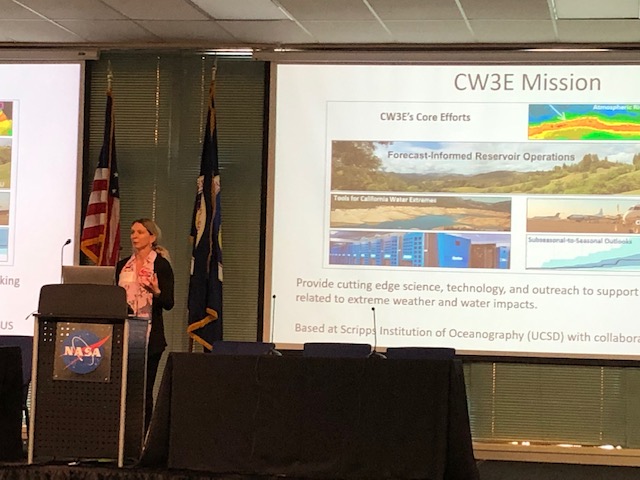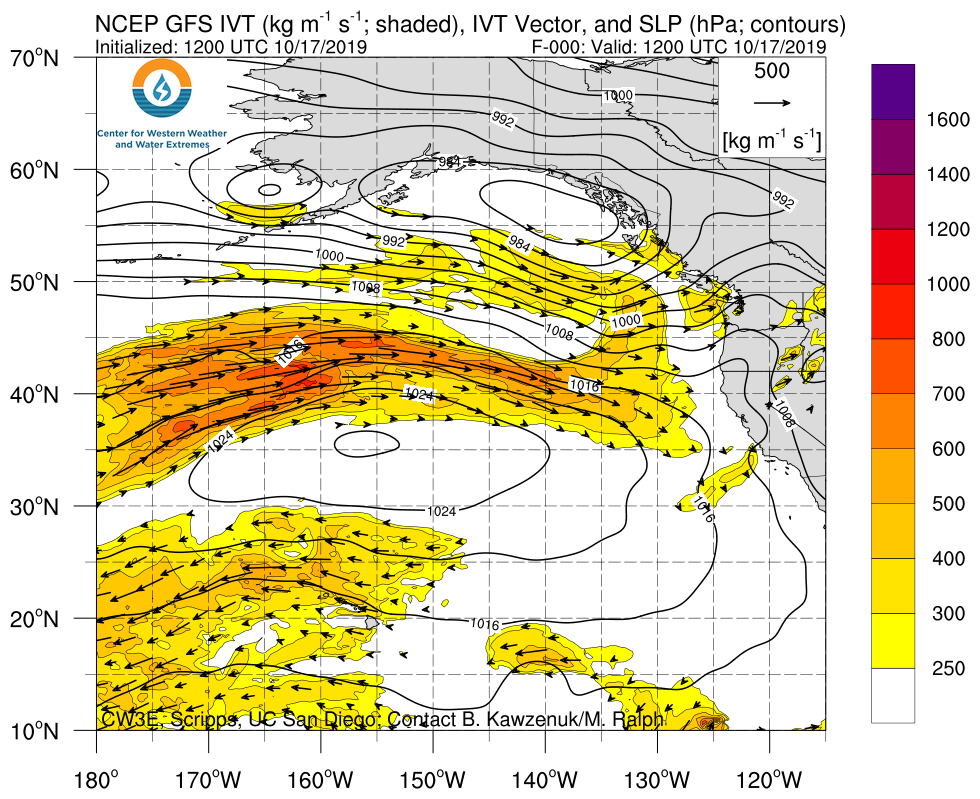CW3E Hosts 11th Annual Winter Outlook Workshop Sponsored by California DWR
November 15, 2019
The 11th Annual Winter Outlook Workshop (WOW), sponsored by the California Department of Water Resources (DWR), took place at Scripps Institution of Oceanography from November 6th-8th, 2019.
The purpose of the WOW meeting, both historically and continuing this year, is to facilitate interaction between the research community and water resource managers on improving subseasonal-to-seasonal (S2S) forecasts of precipitation, atmospheric rivers (ARs), ridging, and other relevant hydroclimate variables for the Western U.S. region.
The 11th Annual WOW meeting began with opening remarks from CW3E Director Dr. Marty Ralph, which was followed by a presentation from Jeanine Jones (DWR Interstate Resources Manager). Her presentation provided an overview of the stakeholder/end user need for better S2S forecasts of precipitation, ARs, and ridging over the western United States. Her talk emphasized that research efforts to better understand S2S predictability of these phenomena is a necessary, but not sufficient, component of DWR-funded S2S work. The main emphasis from a water manager’s perspective is to obtain a useful S2S forecast tool or operational S2S product that can aid in decision support.
Dr. Mike DeFlorio, the lead researcher on S2S at CW3E, spoke in the next presentation about the joint CW3E/JPL efforts over the last year to: a) conduct fundamental research to improve understanding of S2S predictability of precipitation, ARs, and ridging, and b) to produce (or refine existing) experimental S2S forecast products that can aid in decision support for western water applications. His work highlighted both his own research/experimental product development, and the research/product development led by other CW3E/JPL S2S team members. Dr. DeFlorio also highlighted CW3E/JPL’s involvement in the S2S Prediction Project’s Real-time Pilot Initiative, which is a joint Research-to-Operations (R2O) initiative by the World Weather Research Programme (WWRP) and World Climate Research Programme (WCRP) to promote the uptake of S2S forecasts to support users and decision-makers. CW3E/JPL is the only team participating in this global initiative with a water management-related end user representative (California DWR).
The next talk was given by Dr. Sasha Gershunov (CW3E/Scripps), who presented CW3E’s experimental seasonal forecast for precipitation over the western U.S. during the January-February-March period. This work is based on research described in Gershunov and Cayan (2003) and leverages canonical correlation analysis of sea surface temperature (SST) and precipitation over the Pacific/western U.S. region. In addition to presenting this experimental seasonal forecast, Dr. Gershunov also focused on the research that was a necessary condition for providing a potentially useful forecast [Gershunov and Cayan 2003]. Accordingly, he presented a hindcast skill assessment of the statistical model that was used to make the experimental seasonal prediction for this winter.
The first day of the workshop concluded with a talk by Dr. Michael Anderson, the state climatologist at California DWR. His presentation focused on examples of ways that DWR can potentially utilize subseasonal (weeks 3-5 lead time) to seasonal (monthly lead time) forecasts of precipitation, ARs, and ridging over the Western U.S. region.
The second day of the workshop began with a presentation from Dr. David DeWitt, the Director of NOAA’s Climate Prediction Center (CPC). His talk emphasized the various S2S efforts ongoing at CPC, and in particular focused on the importance of the passage of the Weather Act in 2017 (and its reauthorization in 2019), which specifically includes S2S forecasts as a target area for improvement. Dr. Matt Switanek then gave a presentation on the efforts of he and his team at NOAA ESRL to improve statistical S2S forecasts of precipitation over the western U.S. The morning of Day 2 continued with a talk by Dr. Peter Gibson (NASA JPL/CalTech) on experimental subseasonal ridging outlooks that he and Dr. Duane Waliser (NASA JPL/CalTech) have led the development of. These experimental outlooks are supported by several research efforts that Dr. Gibson has led, which all seek to better understand the types of ridges that impact the western U.S., along with providing a subseasonal skill assessment of several dynamical hindcast systems in predicting these ridge types. The last talk of the morning of Day 2 was given by Dr. Rong Fu (UCLA), who presented an experimental seasonal prediction of precipitation over the western U.S. using a similar CCA-based methodology of that employed by the Scripps seasonal forecasting team.
The afternoon of day 2 concluded with several talks by: CW3E Deputy Director Dr. Luca Delle Monache on opportunities for applying machine learning techniques to improve S2S prediction; a joint talk by Dr. Duane Waliser (NASA JPL/CalTech) / Dr. Andy Robertson (IRI) / Dr. Xubin Zeng (University of Arizona) on upcoming work to improve S2S prediction of snowpack over the western U.S.; and a discussion led by Jeanine Jones on potential ways to increase the scope of ocean observations to improve S2S prediction. CW3E Field Research Manager Dr. Anna Wilson, Dr. Bruce Cornuelle (Scripps), Dr. Luca Centurioni (Scripps), and CW3E Deputy Director Dr. Luca Delle Monache also participated in this discussion as panel members.
The final day of the 11th Annual WOW meeting began with a talk by Scripps postdoctoral research Dr. Dillon Amaya, who presented an overview of “Blob 2.0”, a near-record pattern of warm SST anomalies over the North Pacific that emerged during Summer 2019. His talk focused on the extent to which Blob-like warm anomalies could be a source of S2S predictability for drought over the western U.S. region. Dr. Jon Rutz (NWS Western Region) then gave a presentation which provided an overview of research-to-operations in NWS. The final talk of the workshop was given by Jeanine Jones (DWR), which focused on the Colorado River basin and highlighted ways in which improved S2S forecasts of precipitation would benefit stakeholders and end users in this region. The workshop concluded with a roundtable discussion involving all workshop attendees. Each WOW participant provided their general thoughts on the workshop, and identified various pathways going forward to better facilitate efficient S2S R2O efforts for California DWR.



































